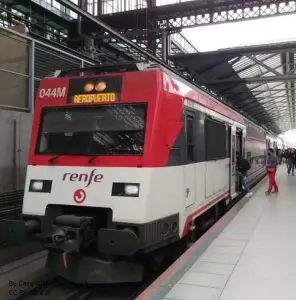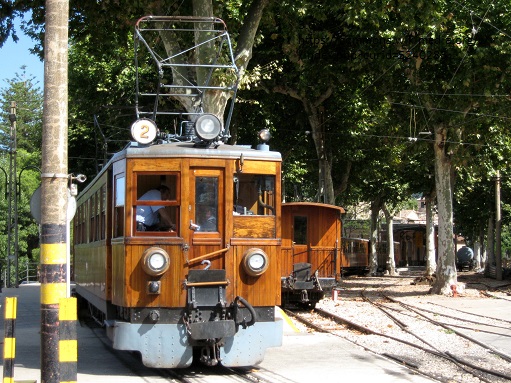Spain has an excellent train network that is both affordable and efficient, making it a fantastic way to explore the country. Here’s a detailed guide to help you navigate the system with ease.
1. Train Companies and Regional Coverage
Spain’s train network is managed by several companies. The state owned (Red Nacional de los Ferrocarriles Españoles), is the primary, national railway operator. Renfe covers most of Spain. Renfe operates everything from non-stop regional capital connections to short-hop commuter services. Iryo and Ouigo, the other main train operators, provide low-cost alternatives on the main high-speed intercity lines.
The different services offered and the different train types can seem a bit confusing. The trains in Spain can generally be divided into three categories:
- Long distance trains (larga distancia):
Mainly high-speed, long-distance services link many of the major cities, mainly via Madrid. These full-service trains can reach 310km/h (193mph). RENFE’s high speed train is known as the AVE (Alta Velocidad Española), with the lower cost Avlo also run by RENFE in order to compete with the no frills services offered by the newer train operators Iryo and Ouigo.If you’re travelling on an AVE service from a mainline station, you will have to pass through a luggage security scan, just like at the airport. This should only take a few minutes but can be longer for busy services, so do allow extra time. - Mid-distance services (media distancia) – these trains make up the majority of other major routes. They do also travel quite fast, although not as fast as the AVE and cover fairly long distances.
 Slower trains, (Regional, Proximidad, and Cercanías) are the more local trains which are used more by commuters. They are much slower and stop at all the stations along the way.
Slower trains, (Regional, Proximidad, and Cercanías) are the more local trains which are used more by commuters. They are much slower and stop at all the stations along the way.
2. Getting the best price/route
Unlike in the UK, travelling by train is a relatively cheap way of getting around, as the network is still owned by the state and so British tourists are often surprised by how cheap it is to travel by train in Spain.
With an extensive and well connected network, it offers a comfortable and easy way to explore the country, however, the prices can vary significantly depending on various factors such as the class of travel, how far in advance you buy your ticket and the route you take.
One of the main factors that influences the price of the ticket is the class of travel. In Spain there are three different classes, Turista, Turista Plus and Preferente. These are nothing to do with tourists! It basically means second class or economy, Turista Plus is like premium economy and Preferente means First Class.
The other main factor is how far in advance you purchase your tickets and the route you travel.
Whilst you can purchase your tickets direct from the train operators’ websites,
Omio is an official partner of RENFE and offers a great way to pre-book your tickets as it all comes in English. By buying in advance you will ensure you get the best price. Also, by purchasing your ticket in advance, you will guarantee your seat for the journey, which in high season can be a real benefit when the trains can get very busy.
At a local railway station
If you have not purchased your ticket in advance, they can also be purchased at the rail station, but be prepared to pay a significant amount more in some cases.
Free travel on local trains
It is also useful to know that if you are buying a ticket for a high speed, inter-city train, on your ticket you will find a code for “Combinado Cercanias”. This means that your ticket included free travel on local trains to get to the mainline station. So, if you are staying in another part of even outside the city of departure, you can use the local trains to get to the mainline station. All you have to do is select “Combinado Cercanias” as your fare and enter the 5 digit code from your ticket into the ticket machine.
The code can be used for 4 hours prior to departure and also 4 hours after your arrival on the local trains at your destination.
RENFE Spain pass
If you are planning on visiting several cities, the RENFE Spain pass may be worth considering. This ticket allows you to travel on the AVE and other long distance trains for a fixed number of journey during a ser period of time. It can be particularly useful if you want some flexibility in your itinerary.
https://www.renfe.com/es/en/travel/prepare-your-trip/abonos-ave-y-largadistancia/renfe-spain-pass
3. Tourist Routes by train
Travelling by train does not have to just be a means to an end. Exploring Spain by train can be an experience in itself which allows you to enjoy spectacular scenery and historical cities.
Here are some highly recommended tourist journeys by train through Spain which you might wish to consider.
Al Andalus Train
The Al Ándalus train is a luxury tourist train, operated by Renfe. It offers a high-end travel experience through Andalusia and other regions, featuring vintage 1920s Belle Époque-style carriages, gourmet dining, guided excursions, and five-star accommodations on board. The train typically runs routes that explore cities like Seville, Granada, Córdoba, and Ronda, providing a unique way to experience Spain’s history, culture, and landscapes.
El Transcantábrico
Another luxury tourist train offering scenic journeys long the northern coast of Spain through Galicia, Asturias, Cantabria and the Basque Country. This route passes through charming villages, breathtaking landscapes and historic cities. The passengers can also experience the gastronomy of the región. The train is known for its slow scenic pace, allowing travellers to enjoy the Green Coast, while experiencing first class service.
Tren de la Fresa (Strawberry Train)
A historic tourist train that runs between Madrid and Aranjuez. It is one of Spain’s most iconic heritage train experiences, designed to recreate the journey of the first railway line in Madrid, which opened in 1851.
The train includes historic wooden coaches pulled by a classic locomotive. Passengers enjoy period-costumed attendants, who offer strawberries (a specialty of Aranjuez) during the ride. The trip includes guided tours of the Royal Palace, gardens, and other historical sites.
The train typically operates on weekends in spring and autumn, making it a great seasonal attraction.
El Tren de Soller
The Tren de Sóller is a historic narrow-gauge railway that connects Palma de Mallorca with the town of Sóller on the island of Mallorca. It is one of Spain’s most scenic and nostalgic train journeys.
The train dates back to 1912 and has beautifully restored wooden carriages with brass fittings. It travels the 17 mile journey through the Tramuntana mountains, crossing the viaducto de los Cinc Ponts on the way.
This train is a popular attraction for tourists visiting Mallorca and offers a unique way to explore the island’s natural beauty and history.

Related articles
Guide to using the metros in Spain
There are five Metro systems in Spain, one in each of the following cities: Madrid, Barcelona, Valencia, Bilbao and Palma
Getting around Spain by bus
Spain boasts an extensive and efficient bus network that offers tourists an affordable and flexible way to explore the country.
Driving in Spain
Driving in Spain is a great way to experience stunning landscapes, scenic coastal roads, and well-maintained highways, but before you
